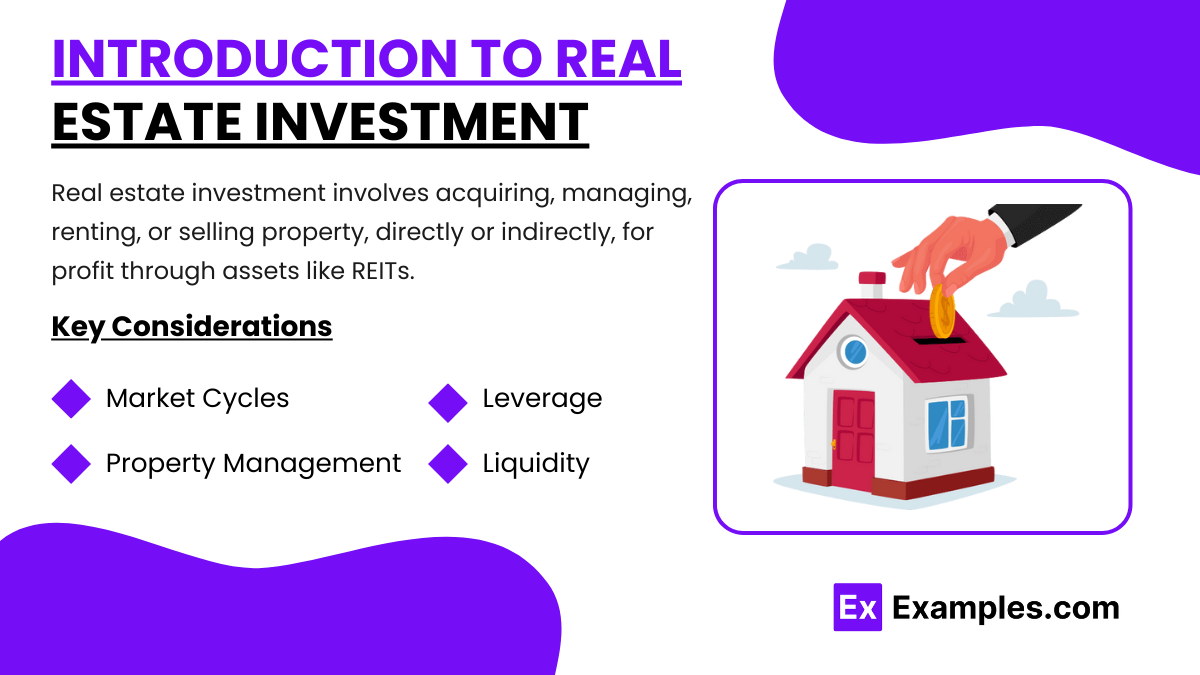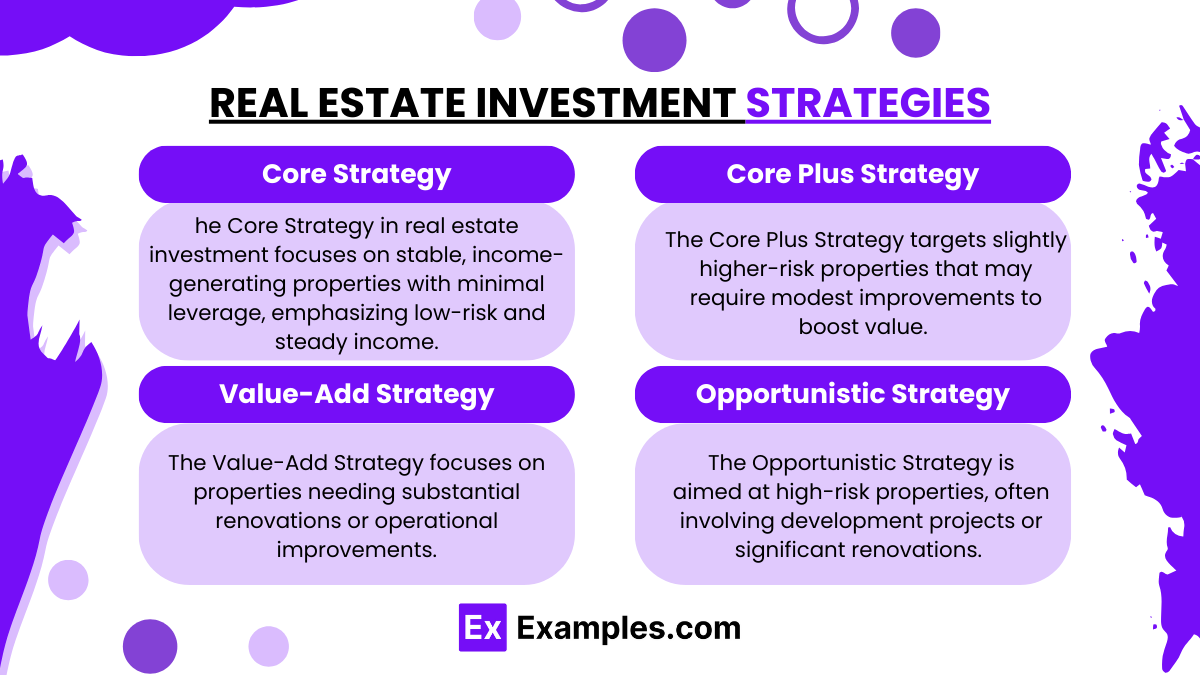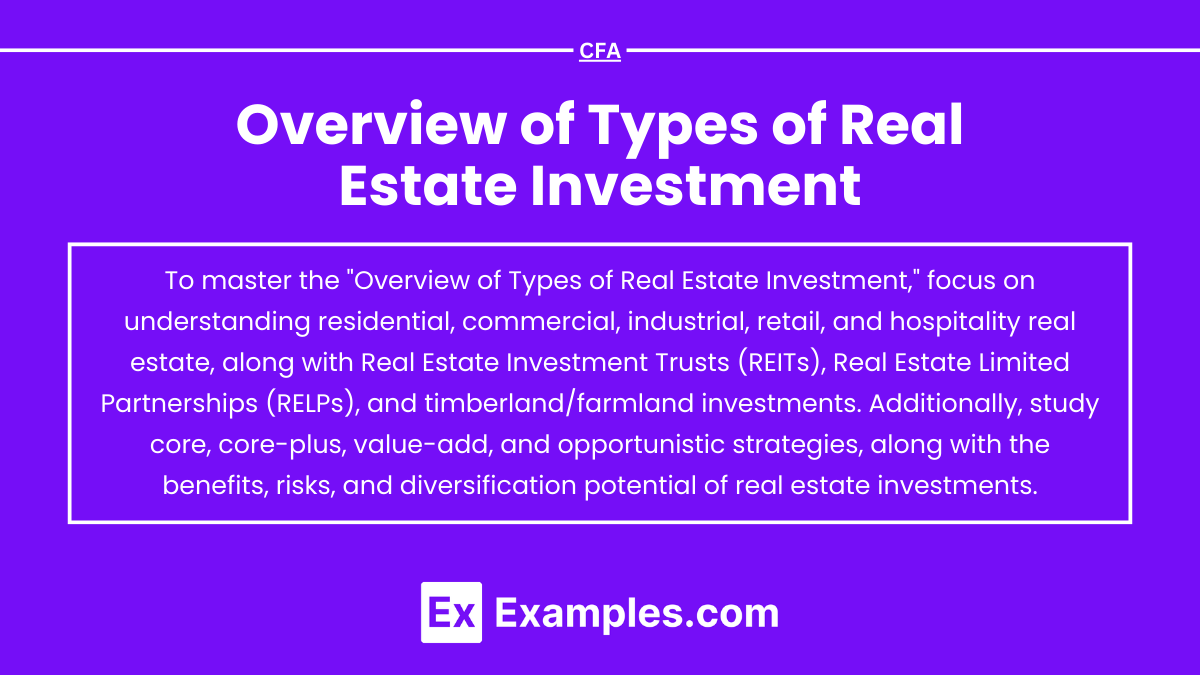Real estate investment encompasses a diverse range of asset types and strategies, each offering unique benefits and challenges for investors. This sector includes residential, commercial, industrial, and retail properties, as well as specialized investments like Real Estate Investment Trusts (REITs) and Real Estate Limited Partnerships (RELPs). Real estate can provide portfolio diversification, income generation, and a hedge against inflation. However, it also carries risks, including market fluctuations, liquidity constraints, and management demands. Understanding these types enables informed decisions aligned with investment goals.
Learning Objectives
In studying ” Overview of Types of Real Estate Investment ” for the CFA Exam, you should learn to understand the various types of real estate investments, including residential, commercial, industrial, retail, hospitality, and specialized assets like timberland and farmland. Analyze how each type offers distinct income and capital appreciation opportunities and evaluate the associated risks and return profiles. Assess investment strategies—core, core-plus, value-add, and opportunistic—and their suitability for different investor profiles. Additionally, explore the role of Real Estate Investment Trusts (REITs) and Real Estate Limited Partnerships (RELPs) in providing access to real estate markets, and apply this understanding in portfolio diversification analysis.
Introduction to Real Estate Investment

Real Estate Investment refers to the purchase, ownership, management, rental, or sale of real estate (land and buildings) for profit. This type of investment includes both direct investments, where investors physically acquire property, and indirect investments, such as through publicly traded real estate securities like REITs (Real Estate Investment Trusts) or real estate mutual funds. Real estate investments aim to generate income, typically through rental income, and/or appreciation in property value over time. Real estate is often considered a long-term investment and can provide diversification, inflation protection, and potential tax benefits within a portfolio.
Key Considerations in Real Estate Investment
Investors evaluate real estate on a mix of qualitative and quantitative factors. The location, property type, economic environment, and supply-demand dynamics are critical. Additional factors include:
- Market Cycles: Real estate markets are subject to cycles driven by economic growth, interest rates, and demographic shifts, impacting property values and rental income.
- Property Management: Effective property management is vital in real estate investments. Poor management can lead to increased vacancies, lower rental income, and higher operating costs.
- Leverage: Real estate investments often involve significant debt financing, or leverage, which can amplify both gains and losses. Interest rates, loan terms, and financing availability directly affect the cost of capital and investment performance.
- Liquidity: Compared to stocks and bonds, real estate is generally less liquid, as it takes time to buy, sell, or lease properties. This illiquidity can pose a challenge for investors needing quick access to cash.
Types of Real Estate Investments

Types of Real Estate Investments refer to the various categories of property assets in which investors can allocate capital to generate income, achieve diversification, or secure asset appreciation. These types are primarily classified based on the property’s function, income potential, and risk-return profile, encompassing residential, commercial, industrial, retail, hospitality, real estate investment trusts (REITs), real estate limited partnerships (RELPs), and specialty types like timberland and farmland.
- Residential Real Estate
- Description: This includes single-family homes, condominiums, and apartment buildings. It is commonly pursued by individual investors, though institutional investments in residential real estate are growing.
- Benefits: Generates rental income and can appreciate over time. It often exhibits lower volatility compared to stocks.
- Risks: Tenant vacancies, market downturns, and property maintenance costs. Residential real estate values are heavily influenced by location, economic cycles, and demographic trends.
- Commercial Real Estate
- Description: Properties used for business purposes, such as office buildings, retail spaces, industrial complexes, and hotels.
- Benefits: Generally provides higher rental income and longer lease terms, creating stable cash flows.
- Risks: Economic downturns can decrease demand for commercial space, resulting in lower occupancy rates and rental income. Property values can be impacted by interest rates, economic cycles, and sector-specific factors (e.g., the rise of e-commerce affecting retail spaces).
- Industrial Real Estate
- Description: Warehouses, distribution centers, and manufacturing facilities, essential for logistics and supply chain operations.
- Benefits: Demand for industrial properties has surged due to the growth of e-commerce, creating strong rental potential.
- Risks: Dependent on industrial demand, which can be cyclical. Location is critical, as industrial real estate needs to be near major transportation hubs.
- Retail Real Estate
- Description: Shopping centers, malls, and storefronts leased to retailers.
- Benefits: Tenants often sign long-term leases, providing stable income streams.
- Risks: The retail sector is highly susceptible to economic conditions and consumer behavior. The trend towards online shopping has negatively impacted traditional retail spaces.
- Hospitality Real Estate
- Description: Hotels, resorts, and other accommodation facilities that cater to tourists and business travelers.
- Benefits: Income is generated through room rentals and ancillary services (e.g., dining and event hosting). Hospitality real estate can benefit from strong travel demand.
- Risks: Highly volatile, as it depends on economic cycles, seasonal fluctuations, and events affecting tourism. The COVID-19 pandemic highlighted the sector’s vulnerability to global crises.
- Real Estate Investment Trusts (REITs)
- Description: REITs are companies that own, operate, or finance income-producing real estate. They offer exposure to real estate without the need to directly own properties.
- Benefits: Liquidity and accessibility for investors, as REITs are typically publicly traded on stock exchanges. They allow diversification and generally offer high dividend yields.
- Risks: Subject to market volatility and interest rate risk. Additionally, they have regulatory requirements, such as distributing a large portion of income to shareholders, which can limit reinvestment.
- Timberland and Farmland
- Description: Investment in agricultural land or forest land used for producing crops, livestock, or timber.
- Benefits: Provides potential income through crop or timber sales, with possible appreciation over time. Offers inflation protection and low correlation to traditional asset classes.
- Risks: Subject to natural risks (e.g., droughts, pests, fires) and market demand for commodities. Both types require specialized management knowledge and have low liquidity.
Real Estate Investment Strategies

Real Estate Investment Strategies refer to distinct approaches investors use to acquire, manage, and potentially sell real estate assets to achieve specific financial goals. These strategies vary in terms of risk, return expectations, property types, and investment horizons.
- Core Strategy : The Core Strategy in real estate investment focuses on stable, income-generating properties with minimal leverage, emphasizing low-risk and steady income. This strategy typically targets prime properties located in established markets, where tenant demand and property values are resilient. Investors following this approach seek moderate returns, primarily derived from rental income rather than property appreciation. The low-risk nature of this strategy appeals to conservative investors aiming for predictable, long-term returns with lower exposure to market fluctuations.
- Core Plus Strategy : The Core Plus Strategy targets slightly higher-risk properties that may require modest improvements to boost value. Typically, these properties are in secondary locations or have potential for value-added opportunities. Investors can expect moderate returns from both rental income and some capital appreciation.
- Value-Add Strategy : The Value-Add Strategy focuses on properties needing substantial renovations or operational improvements. This approach carries moderate to high risk, as it involves actively increasing property value through intensive management. Return expectations are higher, with gains coming from both income and property appreciation.
- Opportunistic Strategy : The Opportunistic Strategy is aimed at high-risk properties, often involving development projects or significant renovations. This strategy involves high leverage and speculative elements, targeting properties with the potential for transformative value growth. Investors pursue the highest returns, primarily through capital gains.
Examples
Example 1: Residential Real Estate
Residential properties include single-family homes, duplexes, townhouses, and apartment buildings. This sector is highly popular among individual investors and offers income through rental payments, as well as potential appreciation over time. Residential real estate generally has lower volatility compared to commercial properties, largely because housing is a fundamental need. However, investors must consider factors such as market conditions, tenant occupancy rates, property management, and maintenance costs. Residential properties are particularly sensitive to location and neighborhood quality, making these crucial factors for value retention and growth.
Example 2: Commercial Real Estate
This category includes office buildings, retail stores, hotels, and other properties used for business activities. Commercial real estate often appeals to institutional investors due to its longer lease terms and relatively stable cash flow from tenant rentals. Commercial properties can yield higher returns than residential real estate, especially in prime locations or high-demand business districts. However, these investments are more sensitive to economic cycles and face risks related to market demand, tenant defaults, and sector-specific shifts—such as the e-commerce trend impacting physical retail spaces. Proper management and understanding of economic trends are essential for success in this sector.
Example 3: Industrial Real Estate
Industrial properties comprise warehouses, manufacturing facilities, and logistics centers, which are integral to supply chain operations. This sector has gained traction due to the growth of e-commerce, which has driven demand for storage and distribution facilities. Industrial properties offer steady income streams due to long-term leases and low vacancy rates. However, they are highly dependent on location; proximity to transportation hubs, ports, and urban centers can significantly impact their value and demand. Despite the benefits, industrial real estate can be affected by economic cycles and technological advancements, such as automation, which may alter space requirements.
Example 4: Real Estate Investment Trusts (REITs)
REITs provide an accessible way for investors to gain exposure to real estate without directly owning property. A REIT is a company that owns, operates, or finances income-producing real estate, and it is typically listed on major stock exchanges, allowing for easy trading. REITs provide liquidity, professional management, and diversification across different property types and geographical locations. They are especially attractive for their dividend yields, as they are required by law to distribute a significant portion of their income to shareholders. However, REITs are subject to market volatility, regulatory constraints, and interest rate fluctuations, which can impact both share prices and dividend payouts.
Example 5: Farmland and Timberland
These unique forms of real estate investment involve agricultural and forest land. Farmland investments focus on land used for crops or livestock, while timberland is dedicated to forest areas for timber production. These assets generate returns through the sale of agricultural products or timber, offering diversification and a hedge against inflation. Additionally, they have low correlation with traditional assets, making them attractive for portfolio diversification. However, risks include environmental factors (such as droughts, pests, and fires), commodity price fluctuations, and the need for specialized management. Both farmland and timberland are relatively illiquid, as they require long holding periods to realize significant returns.
Practice Questions
Question 1
Which of the following is a primary benefit of investing in commercial real estate?
A. Short-term leases that allow for rapid adjustments to rental income
B. Minimal sensitivity to economic cycles
C. Long-term leases that provide stable cash flows
D. Higher liquidity compared to residential real estate
Answer: C. Long-term leases that provide stable cash flows
Explanation: Commercial real estate typically involves longer lease terms compared to residential properties, which means investors benefit from more stable and predictable cash flows over time. This stability is advantageous as it provides a regular income stream, making commercial real estate an attractive option for income-focused investors.
- Option A is incorrect because short-term leases are more common in residential real estate, and rapid adjustments to rental income are not a primary characteristic of commercial leases.
- Option B is incorrect as commercial real estate is actually sensitive to economic cycles; demand for office and retail spaces, for example, can decline during economic downturns.
- Option D is incorrect because commercial real estate is generally less liquid than residential real estate, making it harder to sell quickly.
Question 2
Which type of real estate investment is most likely to serve as a hedge against inflation due to its underlying asset value and revenue potential?
A. Real Estate Investment Trusts (REITs)
B. Farmland
C. Hospitality Real Estate
D. Industrial Real Estate
Answer: B. Farmland
Explanation: Farmland is known for its potential to hedge against inflation, as it generates income from the sale of crops, which often rise in price during inflationary periods. Additionally, farmland values tend to appreciate over time due to the limited supply of arable land and the rising demand for food and other agricultural products. These characteristics make it a natural inflation hedge.
- Option A (REITs) can provide a hedge against inflation to some extent, but their performance is influenced by market conditions, interest rates, and stock market volatility.
- Option C (Hospitality Real Estate) is highly sensitive to economic cycles and often suffers during downturns, reducing its effectiveness as an inflation hedge.
- Option D (Industrial Real Estate) may see some inflation protection but is generally more tied to economic activity and demand for warehousing and logistics.
Question 3
Which investment strategy is characterized by acquiring properties that require significant renovation or repositioning, with the goal of increasing property value and achieving capital appreciation?
A. Core Strategy
B. Opportunistic Strategy
C. Core Plus Strategy
D. REIT Investment Strategy
Answer: B. Opportunistic Strategy
Explanation : The Opportunistic Strategy involves high-risk investments in properties that require substantial improvements or development. These properties might be underperforming, vacant, or need major renovations. Investors using this strategy aim to increase the value of the property through active management and capital improvements, and then sell it for capital gains once the improvements are complete. This strategy carries a higher risk but offers the potential for substantial returns from capital appreciation.
- Option A (Core Strategy) is incorrect as it focuses on stable, income-generating properties with minimal risk and low leverage, rather than properties requiring substantial renovation.
- Option C (Core Plus Strategy) involves properties with slight improvements or additional value-add potential, but it doesn’t involve the significant repositioning typical of the Opportunistic Strategy.
- Option D (REIT Investment Strategy) is not a specific property investment strategy but rather an investment structure, so it doesn’t fit the description provided.


